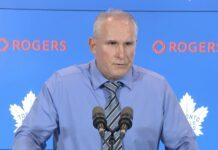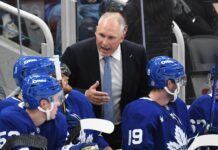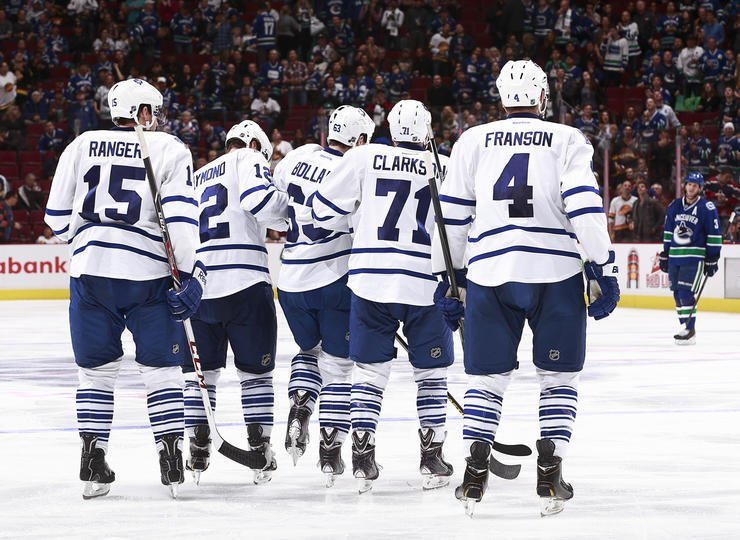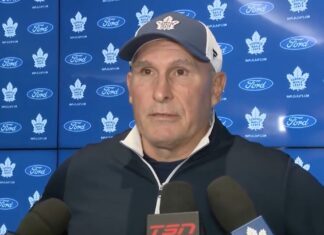Having gone through a long and painful rebuild, the Toronto Maple Leafs now find themselves right smack in the middle of a critical time in their development as an organization.
With legitimate core pieces finally in place, it’s up to management now to make the proper decisions to take this team from a middling group capable of making the playoffs annually to a powerhouse perennial contender.
With that in mind, is locking up Dave Bolland the right move for this organization?
Long Term Contracts and Contention
Consider this: The Leafs have five forwards already signed to big money deals until at least 2017-2018. The only other team that can claim the same is the Philadelphia Flyers. Not exactly flattering company.
Are the Leafs going to take the lead and make it six by adding Dave Bolland?
That would require the Leafs signing Bolland to at least a four year deal, which would pretty well set up their roster for keeping the Bozak line intact, Lupul on second line left wing, Bolland as the third center, and Clarkson on either the right side of line two or line three.
But as was the case when the Leafs locked up Dion Phaneuf, I’ll warn again that the Leafs could be locking up a middling core and need to be extremely careful with how they are approaching their hockey team.
Traditionally, teams have at least won some playoff series before looking up a core for a very long time, but the Leafs are locking up a core that hasn’t won anything while some of their most important young players are still on cheap deals. The Crawford and Bickell contracts, for example, are pretty ugly, but at least they won a Cup with those two in place and can argue that they’re simply trying to keep the band together. The Leafs are in no position to claim such things.
When a team hasn’t had that level of success, it has to constantly be planning for the future as much as it plans for the present. This summer Jake Gardiner and James Reimer need new deals. In a year from now, both Kadri and Bernier will be RFAs again, only with more power this time. With the exception of maybe Reimer, does anyone think any of them will come cheap? Even if the Leafs follow through with trading a Gardiner or Kadri, their replacements won’t be cheap either unless the Leafs give them away for kids and picks (and how counterproductive would that be?). This isn’t time to say, “I’m not worried about [year] six or seven right now [of a player’s contract]. I’m worried about one.” The Leafs aren’t good enough to justify that kind of move and line of thinking just yet.
Fans can make jokes about Pat Quinn for going out and giving up futures to acquire a veteran like Owen Nolan all they want, but he was going for it at the time and it was the right time to do so. Obviously it didn’t work, but at that point in time for the Leafs it made sense to go all in. This edition of the Leafs isn’t ready for that yet.
What good teams do is identify their core, run with it, and fill in the gaps as need be each year.
Teams like Pittsburgh, Chicago and Boston run with their elite players and cycle in good fillers. Pittsburgh has gone through support pieces like Guerin, Hossa and Iginla. Chicago develops young talent, promotes them and pushes out veterans in the way when they’re ready. They’ve done it by drafting and developing players like Kruger, Saad and Shaw, while picking up young guys on the cheap like Frolik, Ladd, and Stalberg.
Meanwhile, Boston have taken on a ton of veterans throughout Chiarelli’s tenure; players such as Ryder, Recchi, Rolston, Corvo, Morris, and Iginla. All those teams kept their core pieces and just rotated the supporting cast when need be. These are the easiest moves to make when a GM has built up his core properly. Good players are available every trade deadline to bolster a roster and fill in the holes the youth proved they couldn’t throughout the first half of the season.
The Leafs biggest problem used to be that they didn’t have pretty well any good NHLers (that’s how Joey Crabb ends up playing on a line with Phil Kessel for a long time). Now, the problem might be that they have just enough good players to start overvaluing what they have instead of keeping the bigger picture in mind.
The Progression Plan
Bolland is a good player, but solid third line centers are available every single trade deadline. This deadline David Legwand and Marcel Goc are available to be acquired, while a good young third line center in Shawn Matthias has been rumoured to be available all year. Matthias has one more year on his deal, so if he doesn’t get moved soon he’ll probably be available again next year and join potential 2015 pending UFAs on the market like Fisher, Vermette, Cullen, and Horcoff.
Beyond that, the Leafs have a good young center that needs ice time in Peter Holland and he isn’t going to develop on the fourth line playing 8-10 minutes a night.
It’s one thing to lock up a bunch of veterans and bring up young players through the bottom lines until they are ready to take on more responsibility (Chicago does this better than anyone), but the Leafs have 1) Not shown any inclination that they want to do anything with their fourth line other than play them sparingly and not really care if they can handle a regular shift if need be, and 2) Have openly discussed how the NHL is about winning and not developing players.
That’s why we don’t really know what the Leafs have in once-promising prospects, who are turning 23 this year and up for new contracts, in Carter Ashton and Jerry D’Amigo. If Bolland is locked up, Holland might end up being grouped in the same category. Could he play wing in the top nine? Probably, but he’s not a winger. The organization is much better served if Holland cashes in on his potential of being a strong two-way center. And if he ultimately doesn’t, it’s easy to find a solid third line center just like that. Heck, they picked up Bolland himself for a few picks.
If the Leafs decided to play their fourth line regularly with some skill on it, centered by Holland, bringing back Bolland for reasonable money won’t be a bad move at all provided he is fully healthy again. But that requires a seemingly radical philosophy change, and how does that saying go? Can’t teach an old dog new tricks?
The plan for this management team has to be to develop kids to properly fill out the roster, so they can be competitive in all facets of the game. That becomes a lot more difficult when they have six (assuming they lock up Bolland) veterans signed to big deals, don’t play a fourth line, and have to find ice time for Kadri along with Holland as well.
There has to be a progression plan in place, and that begins with placing prospects into positions to improve, supporting them through mistakes (which, to their credit, has begun to happen with Rielly, Gardiner and Kadri lately), and developing them in good environments.
When the Wings were struggling with all their young players this season, Mike Babcock came out and said, “We need to do a better job of insulating our younger players and provide better leadership.” The Wings don’t have all the answers in hockey, but they’re getting better results from their kids now and climbing up the standings. Conversely, the Leafs have pitted their kids against each other and made it a “one or the other” type thing. Kadri was called out and told Holland could take his ice time; it also seems like it’s either one of Ashton or D’Amigo, but never both, even though Ashton has played RW in the AHL. Not to mention it was Rielly or Gardiner for a little while in Leafs land. Of course, Reimer or Bernier is a whole story in and of itself, too.
The grand plan can’t be just to trade Reimer and hope Rielly becomes a star while the cap goes up. The Leafs are now on their second straight year of getting elite goaltending on the cheap and that isn’t going to last much longer. They have to start planning for it and managing the cap better than they have been. It hasn’t cost them yet, but when they’re paying someone like Clarkson big money, and now considering Bolland for a long term contract when they have capable kids in the system not even getting ice time, it’s going to catch up to them eventually.
And this all circles back to whether or not they should sign Bolland. Is he going to sign a reasonably priced deal for two years? If so, it makes sense to sign him, but they need to rethink their lineup philosophies if they do agree to bring him back. If he wants a long-term deal? They probably need to pass altogether. This is without even taking into consideration the player, what he might cost, and his injury. Bolland has a history of being disinterested in games throughout the grind of the year. How do you think playing with a specialized boot and weird foot situation will compound that? Don’t let 15 games to start the year dominate the judgment on this player. We haven’t seen the night-in, night-out Bolland, only the good one. He’s also an okay skater, but has never been confused with a speedster; is he slower now?
The Leafs have accumulated a number of good players and have a reasonably strong core hitting its prime (at least on offense; really only looking at JVR, Kessel and Kadri up front), but how they fill out the roster is what will make or break them. To compound things, the East is right there for the taking. It’s a mediocre Conference. A few good moves could catapult them up to the top. A few bad ones could drop them to mediocrity and have them looking to Kessel to carry them every night. To a degree, we can already see how signing Clarkson to that big money deal might corner them in. They’ve dropped him to the third line and desperately searched for a fit since he’s gotten here. We don’t know yet, but that signing might end up costing them Kulemin. The point is that they can’t just keep adding more veterans to this team on long-term deals and blocking out more kids from sticking on the roster in the process. Either play an actual fourth line, or give Holland the 3C spot next season.
With some smart management, this can be the time the Leafs take the next step as an organization and really start becoming contenders to win the East. Conversely, they could sink into that dreaded middle-of-the-conference pack, fighting for a playoff spot every single year, sometimes making it and sometimes not. It’s up to Nonis now.



![Craig Berube on Nick Robertson joining William Nylander’s line: “If he gets to a good area on the ice, [Nylander] can find him… He has to put a couple in and get some confidence” Craig Berube, Toronto Maple Leafs head coach](https://mapleleafshotstove.com/wp-content/uploads/2024/10/berube-leafs-prac-218x150.jpg)





















![Craig Berube on Nick Robertson joining William Nylander’s line: “If he gets to a good area on the ice, [Nylander] can find him… He has to put a couple in and get some confidence” Craig Berube, Toronto Maple Leafs head coach](https://mapleleafshotstove.com/wp-content/uploads/2024/10/berube-leafs-prac-100x70.jpg)







